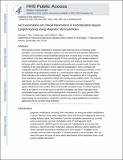An examination of critical parameters in hybridization‐based epigenotyping using magnetic microparticles
Author(s)
Tam, Brooke Elizabeth.; Hao, Yining; Sikes, Hadley D.
DownloadAccepted version (359.9Kb)
Terms of use
Metadata
Show full item recordAbstract
Gene-specific promoter methylation is involved in gene silencing and is an important cancer biomarker. Cancer-specific methylation patterns have been observed and clinically validated for numerous gene promoters, but the knowledge gleaned from this large body of work is currently under-utilized in the clinic. Methylation-specific PCR is currently the gold standard method for clinical methylation assessment, but several research groups have proposed hybridization-based techniques which could be simpler to implement and provide more accurate results. However, the sensitivity of this easier alternative must be improved dramatically in order to compete with methylation-specific PCR. Efficient sample capture is a key step in maximizing sensitivity, so here we investigate the key parameters involved in (i) maximizing the capture of gene-specific target DNA molecules at the surfaces of functionalized, magnetic microparticles and (ii) recognizing DNA methylation using an engineered methyl-CpG-binding domain (MBD) protein. The magnetic bead density, the probe concentration, and the MBD concentration were very important for maximizing detection, and other variables such as the hybridization time also impacted the target capture efficiency but had a smaller effect on the overall methylation assay. The effect of genomic DNA on the capture of the target sequence was also investigated, and model methylated vs. unmethylated target sequences could be distinguished in the presence of 1 ng/μL genomic DNA. The findings we report related to the underlying binding events involved in hybridization-based epigenotyping can be leveraged in combination with the many signal amplification and detection approaches that are currently being developed.
Date issued
2018-11Department
Massachusetts Institute of Technology. Department of Chemical EngineeringJournal
Biotechnology progress
Publisher
Wiley
Citation
Tam, Brooke E. et al. “An examination of critical parameters in hybridization‐based epigenotyping using magnetic microparticles.” Biotechnology progress, vol. 34, no. 6, 2018, pp. 1589-1595 © 2018 The Author(s)
Version: Author's final manuscript
ISSN
8756-7938
1520-6033